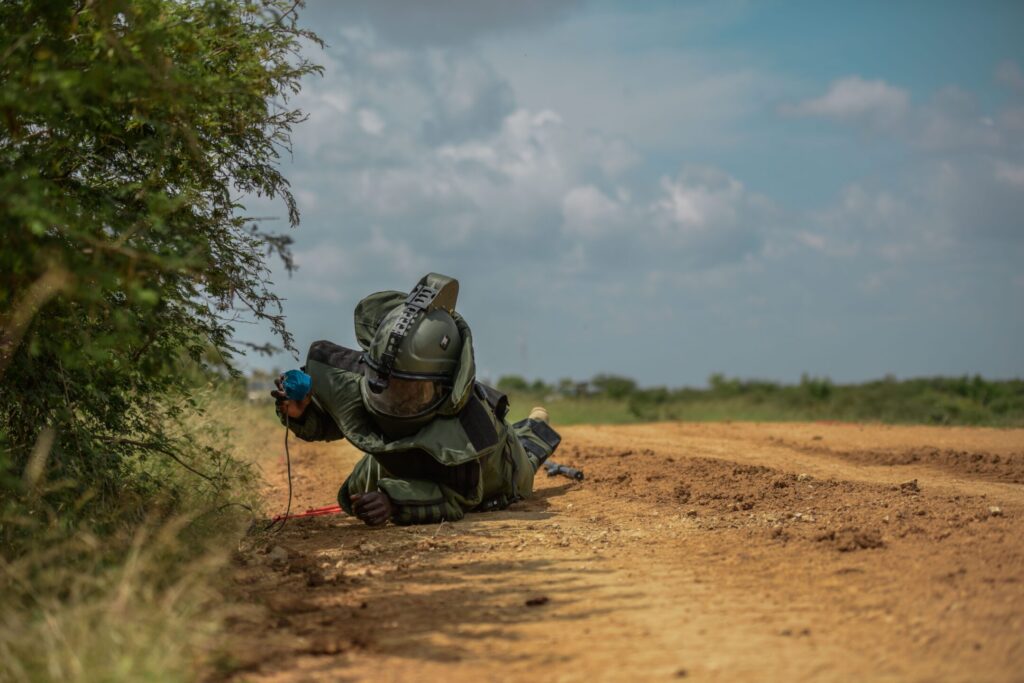In 2023, four of the ten most terrorism-affected countries were in West Africa, with a devastating impact felt across the region from the use of improvised explosive devices (IEDs). In Nigeria, in the same year, more than 100 people lost their lives due to IED-related terrorist attacks. Recognizing the urgent need to strengthen counter-IED (C-IED) efforts at the national and regional levels, the Economic Community of West African States (ECOWAS) held its annual coordination meeting of National Commissions on Small Arms (NATCOMs) in Abuja in October 2024 to adopt a comprehensive strategy.
The deteriorating security landscape across West Africa has seen the threat posed by IEDs[i] become a major concern. For over a decade, violent extremist groups in the Central Sahel and Northeast Nigeria have increasingly used IEDs to attack defence and security forces, with civilian and strategic infrastructure also being targeted in recent years.
Since 2019, the use of IEDs has spread to several coastal West African countries and has become more indiscriminate in nature. Conservative estimates indicate more than 1,600 IED incidents between 2010 and mid-2022, killing at least 6,680 people and injuring a further 9,032 (see Figure 1). The real toll, however, is likely to be far higher. A recent report of the United Nations Secretary General noted that IEDs “exacerbate economic loss, displace civilian populations, cripple critical infrastructure and result in environmental contamination, ultimately impeding achievement of the Sustainable Development Goals.”

Figure 1: Number of IED-related incidents in West Africa by year from 2010 to mid-2022. Figure uses data compiled from Armed Conflict Location and Event Data Project, Global Terrorism Database, and author’s open-source and semi-open-source research.
A critical challenge in West Africa, that is aggravated by the region’s porous borders, is addressing the supply chain of components and explosives used in the production of IEDs. These may be manufactured from explosives diverted from military stores or from the commercial mining sector, but they can also be produced from commonly available goods used in industry and agriculture in western Africa. Beyond supply control, responses to IED require coordination across society. From law enforcement and the criminal justice system, to providing support to victims, to learning from previous incidents to create effective legislation, policies and good practices that can be promoted.
National and regional responses
West African countries have adopted national legislation addressing IED proliferation and use, which has been influenced by regional frameworks, such as the ECOWAS counter-terrorism strategy and implementation plan. The UN Convention against Transnational Organized Crime and the Anti-Personnel Mine Ban Convention have also played an important role in informing and guiding legislative responses in several countries.
In an effort to attack IED production networks, West African countries have intensified joint operations to reduce the proliferation of illicit explosive materials and apprehend actors involved. These operations have been complemented by international cooperation to increase national C-IED capacity, including training on countering supply and understanding the extent of IED contamination within a given territory, as well as State-to-State knowledge sharing.
To date, however, such responses have not been consistently coordinated. Interventions often only tangentially address the threat posed by IEDs, and there has been little scope for actors to ensure they are complementing each other’s efforts. Inadequate data collection and sharing have also reduced the effectiveness of responses, limiting their ability to comprehensively address the full range of issues and actors involved in C-IED.
Member States agreed on the inadequacy of current responses during ECOWAS’ annual meeting of NATCOMs in Dakar in December 2023, identifying common challenges and regional priorities. At this year’s annual meeting in Abuja, Nigeria, West African leaders underlined the value of an overarching regional strategy led by ECOWAS to enhance and coordinate C-IED efforts, guiding both national and inter-State initiatives.
Toward a regional approach
Since 2020, ECOWAS and its Member States have been exploring a regional approach to countering the threat posed by IEDs. This approach is supported by the resolution presented during First Committee to the UN General Assembly, which encourages the development of regional approaches to address this significant challenge to international peace and security.
West African countries are undertaking self-assessments of their C-IED prevention, preparedness, response and mitigation capabilities, notably through the use of UNIDIR’s Capability Maturity Model and Self-Assessment Tool. This tool enables countries to assess their capacity across 16 upstream and downstream components (see Figure 2) and helps them to identify ongoing priorities and challenges. The results also inform the priorities for the regional approach and, by defining the baseline, provide benchmarks for future monitoring and evaluation of national and overall regional progress.

Figure 2: Upstream and downstream components of counter-IED capability.
Building on the consensus reached in Dakar last year, the 2024 ECOWAS NATCOMs meeting in Abuja marked another significant advancement. Member States agreed on the essential components of a draft regional strategy which includes:
- Strengthening national policies and regulatory frameworks to address IED threats
- Implementing IED risk education initiatives to raise public awareness
- Enhancing border controls and securing the management of explosives
- Facilitating regional and international cooperation, including intelligence sharing
- Developing technical capacities for IED scene exploitation and evidence analysis
- Improving victim assistance programmes for those affected by IED incidents
The path forward
Having agreed on the structure of the regional C-IED strategy, ECOWAS is now conducting national expert consultations with technical support from UNIDIR. The aim is to finalize an actionable plan by early 2025, enabling implementation soon after the strategy is adopted. This groundbreaking regional initiative will empower West Africa countries to respond to the threats posed by IEDs through new enhanced regional cooperation modalities.
With the new approach, countries will be able to strengthen their national legislative and regulatory frameworks, build the capacity of relevant national agencies and engage with communities to prevent, mitigate and respond to harms caused by IEDs. Regionally, this will contribute to enhanced joint intelligence collection and information sharing, successful criminal investigations and prosecutions across borders, and fewer avenues for trafficking IED components.
ECOWAS and its Member States are on track to set a pioneering example of regional cooperation to counter the threats posed by IEDs. This approach positively responds to the UN Secretary General’s call for stronger regional cooperation and information sharing to address the multifaceted drivers and impacts of this transnational scourge. Ultimately, it offers hope to the communities most affected by the proliferation of IEDs for a more secure future.
[1] Whilst there is no universally accepted definition, the UN Mine Action Service defines an IED as: “A device placed or fabricated in an improvised manner incorporating destructive, lethal, noxious, pyrotechnic or incendiary chemicals and designed to destroy, incapacitate, harass or distract. It may incorporate military stores, but is normally devised from non-military components.”


